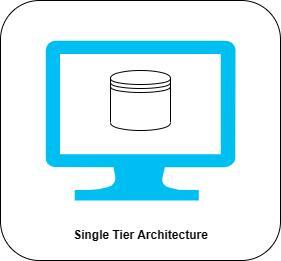
 Data Structure
Data Structure Networking
Networking RDBMS
RDBMS Operating System
Operating System Java
Java MS Excel
MS Excel iOS
iOS HTML
HTML CSS
CSS Android
Android Python
Python C Programming
C Programming C++
C++ C#
C# MongoDB
MongoDB MySQL
MySQL Javascript
Javascript PHP
PHP
- Selected Reading
- UPSC IAS Exams Notes
- Developer's Best Practices
- Questions and Answers
- Effective Resume Writing
- HR Interview Questions
- Computer Glossary
- Who is Who
DBMS Architecture 1-level, 2-Level, 3-Level
Database management systems (DBMS) are crucial tools for effectively managing and arranging enormous volumes of data. A DBMS's general structure and the way data is arranged and managed inside the system are referred to as its architecture. The 1-level, 2-level, and 3-level architectures are only a few of the several architectural concepts that have developed over time. We will examine the features, benefits, and use cases of each of these architectures in detail in this post.
1-Level Architecture
The 1-level architecture, commonly referred to as monolithic or centralized architecture, is the most straightforward type of DBMS design. Data storage, query processing, and user interfaces are all closely integrated into a single system under this architecture of the DBMS. One machine, usually a mainframe or a powerful server, houses the whole system

Characteristics
The DBMS's components are all closely connected and housed on a single system.
The storage, retrieval, and processing of data are all managed by the DBMS.
One point of administration and control is offered by the centralized architecture.
The lack of network overhead makes data access and query processing generally quick.
Due to its reliance on a single machine, the system may not be scalable or fault tolerant.
Use Cases
1-Level architectures are appropriate for modest applications or situations where the user effort and data volume are modest. Small enterprises, non-critical systems, or personal database applications that don't need a lot of scalability or fault tolerance frequently employ them.
Two-Level Architecture
The two-level architecture, sometimes referred to as the client-server architecture, established a division between the client applications and the database server. This concept offered a more scalable and adaptable approach to managing databases by addressing some of the drawbacks of the 1-level design.

Characteristics
Two key parts make up the architecture: a database server and client programs.
The database server is in charge of controlling data storage, handling queries, and facilitating data access.
In order to execute data operations and provide information to users, client apps, sometimes referred to as front-end applications, communicate with the database server.
The database server controls concurrent access to data, preserving the accuracy and reliability of the data.
The client programs and the server communicate with one another across a network, often using a protocol like TCP/IP.
Use Cases
2-Level architectures are often utilized in a broad range of situations, from modest applications to substantial systems. As numerous clients may connect to the database server at once, they boost scalability. Furthermore, the separation of the server and client components enables dispersed deployment, simplifying horizontal scaling and handling of growing workloads.
3-Level Architecture
A more organized and modular method of database administration was presented by the 3-level architecture, sometimes referred to as the schema-based or three-schema architecture. The exterior schema, the conceptual schema, and the internal schema are the further divisions of the DBMS into three layers.

Characteristics
The user view, or external schema, depicts how each unique user sees the database. It establishes how consumers view and engage with the data, offering a personalized and specialized perspective.
The conceptual schema, sometimes referred to as the logical perspective, depicts how the entire database is organized and structured overall. It outlines the data model's entities, connections, and limitations.
The internal schema, often known as the physical view, describes the specifics of the database's actual implementation. It describes the storage level access and storage of data.
The three schemas offer a distinct division between the user interface, the physical storage specifics, and the logical representation of data.
Flexibility and maintainability are increased since changes to one schema don't always need changes to the others.
Use Cases
In complicated database systems where the requirement for numerous user perspectives, data independence, and scalability is present, 3-Level architectures are frequently used. When various users or departments demand tailored views of the data, they are frequently employed in enterprise-level systems. The internal, conceptual, and external schemes are divided to make the database system's maintenance and development simpler.
Conclusion
When evaluating a DBMS's performance, scalability, and flexibility, its architecture is key. In a DBMS, the 1-level, 2-level, and 3-level designs describe several methods of handling and organizing data.
Database administrators and designers may choose the best architecture for their unique requirements by having a thorough understanding of these various designs. The choice of architecture is influenced by aspects including data volume, user workload, scalability requirements, desired degrees of data independence, and customization. Each architecture has its advantages and disadvantages.
Organizations may develop and deploy reliable and effective DBMS systems that satisfy their data management demands and successfully support their business operations by taking into account these architectural models and their features.

